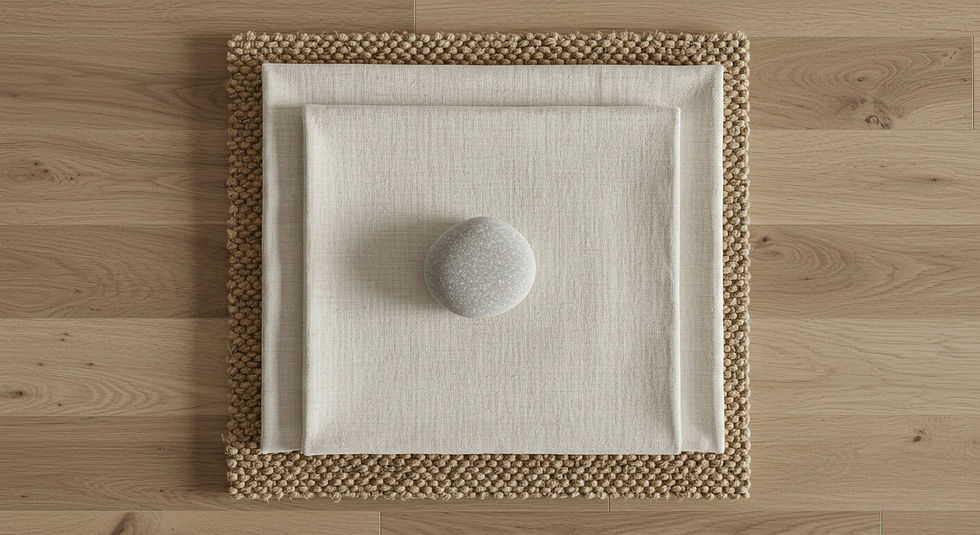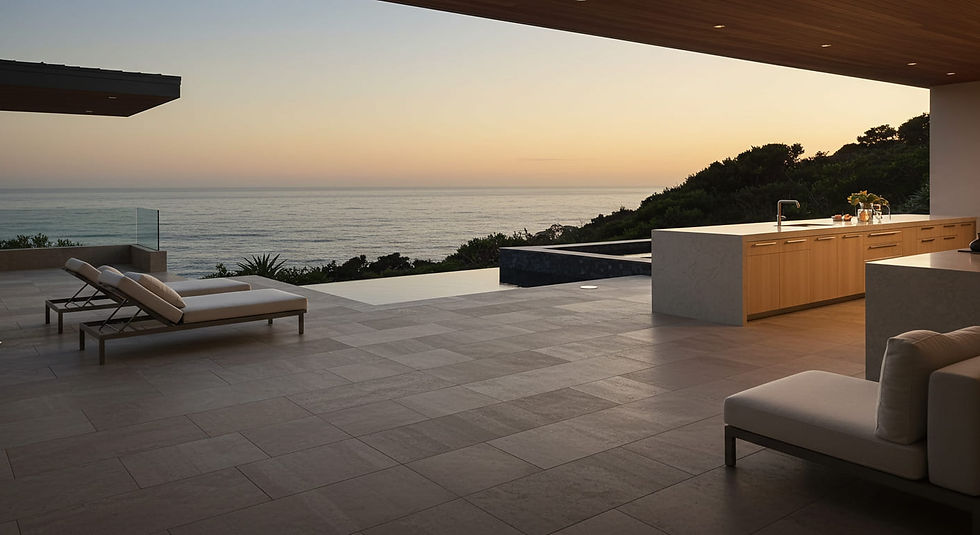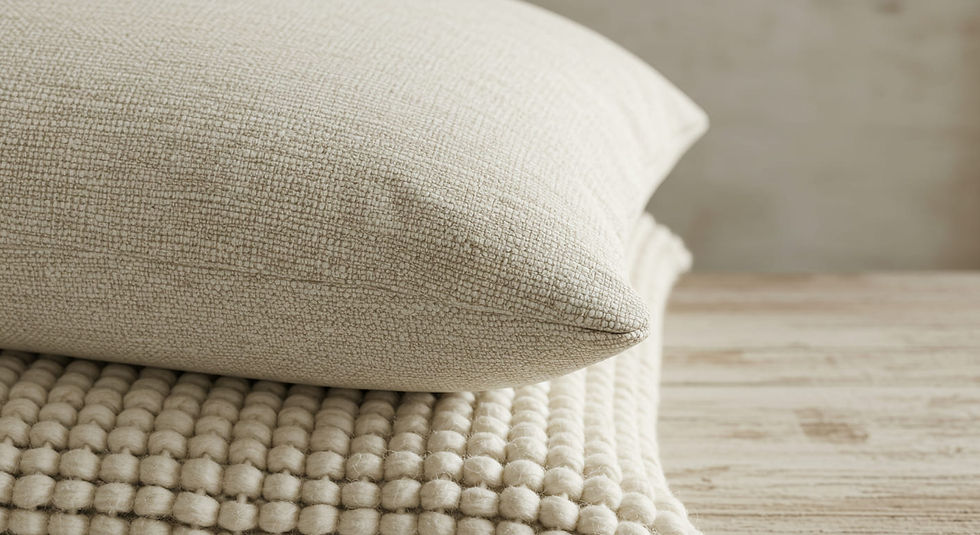
Coastal Contemporary
The serenity of the shore, refined
The Philosophy of Coastal Contemporary
Coastal Contemporary is a sophisticated evolution of the classic beach house, an architectural language that translates the feeling of the shore into a framework for serene, modern living. It moves beyond nautical clichés to capture the essential qualities of the coast: the abundant light, the natural textures, and the expansive sense of calm. This aesthetic is defined by a disciplined, airy palette, an honest use of materials, and an unwavering focus on dissolving the boundary between the interior and the horizon. The result is a sanctuary of effortless, year-round luxury—a space that is both deeply comfortable and exquisitely refined.
The Design Principles of Coastal Contemporary
Every aesthetic is a composition, built upon four fundamental principles of design. Here is how Coastal Contemporary utilizes Form, Pattern, Color, and Light to create its signature atmosphere.
Form & Geometry

The geometry of this aesthetic is defined by clean, horizontal lines that echo the horizon. Forms are open, uncluttered, and often monolithic, creating a sense of expansiveness and calm. High, vaulted ceilings with expressed beams add volume and a subtle architectural detail, while furniture is typically low-profile to preserve sightlines and maintain focus on the view.
Form & Geometry Tags
Geometric Language
Linear & Planar
Level of Articulation
Monolithic & Seamless
Surface Character
Soft & Hand-Formed
Pattern & Applications

Pattern is almost exclusively organic and textural, derived from the inherent qualities of natural materials. It is found in the deep weave of a jute rug, the slub of a linen curtain, the subtle grain of bleached wood, or the rippled surface of handmade tile. Applied decorative patterns are used with extreme restraint, ensuring the atmosphere remains serene and uncluttered.
Pattern & Application Tags
Pattern Source
Organic
Pattern Structure
Random & Allover
Pattern Character
Minimal & Subtle
Color & Tone

The color palette is a direct translation of the coastal landscape: the soft, warm whites of sun-bleached sand, the misty greys of a morning fog, and the muted blues and greens of the ocean. It is a tonal and serene narrative, low in contrast, designed to capture and reflect natural light, creating an atmosphere that is both airy and deeply calming.
Color & Tone Tags
Palette Category
Tonal & Serene
Signature Palette
The California Coast
Light & Atmosphere

Light is the primary material in Coastal Contemporary design. The architecture is engineered to capture it, with expansive glazing and open volumes. The atmosphere is defined by bright, airy, and diffused natural light that connects the interior to the ever-changing conditions of the sky and sea, creating a feeling of profound openness and tranquility.
Light & Atmosphere Tags
Primary Light Source
Natural & Fenestration
Light Quality
Soft & Diffused
Light Temperature & Tone
Warm, Inviting, or Natural
The Signature Coastal Contemporary Component Palette
This is the tangible vocabulary of the aesthetic. The Coastal Contemporary material palette is a curated collection of authentic, textural elements that bring the design principles to life. Understanding these signature components is key to grasping the core characteristics of Coastal Contemporary style—a serene vision built from a disciplined edit of natural materials.

Architectural Surfaces & Finishes
The foundational canvas is designed to be bright, textural, and reflective of natural light. Surfaces are chosen for their soft, tactile qualities and their connection to the coastal environment, creating an envelope that is serene, airy, and sophisticated.
Beached & Weathered Woods: Wide-plank European white oak is used for flooring and custom, flat-panel cabinetry to create a light, warm, and cohesive foundation.
Light-Veined Stone: Honed quartzite, like Taj Mahal, or soft Calacatta marbles are chosen for countertops for their durability and subtle, elegant veining that mimics patterns in sand.
Limewash Plaster: Used as the primary wall finish, its soft, matte texture and subtle movement capture and diffuse light beautifully, creating a more elevated feel than standard paint.
Handmade Tile: Zellige or similar artisanal tiles in shades of white or sea glass are used as feature elements for backsplashes and shower walls, their imperfections adding character.
Apertures & Architectural Passages
Apertures are the primary tool for achieving the aesthetic's core goal: dissolving the boundary between inside and out. They are designed to be as large and unobtrusive as possible, maximizing views, light, and airflow to create an experience of living within the landscape.
Expansive Glazing Systems: Floor-to-ceiling sliding or pocketing glass doors with the thinnest possible frames are essential for creating an effortless indoor-outdoor flow.
Minimalist Frames: To maintain focus on the view, window and door frames are typically thin-profile. Black steel or aluminum creates a crisp, graphic outline that frames the landscape like art, while bleached wood offers a softer, warmer integration.
Vaulted Ceilings: High, often vaulted ceilings with exposed, light-colored wood beams enhance the sense of volume and airiness, drawing the eye upward and making the space feel expansive.


Fixtures, Hardware & Integrated Systems
The approach to fixtures and hardware is one of warm, understated luxury. Forms are simple and elegant, while materials are chosen for their ability to develop a natural patina, adding a layer of soulful, evolving character to the serene palette.
Unlacquered Brass: Used for plumbing fixtures and cabinet hardware, its living finish will gently patinate over time with exposure to the coastal air, adding a layer of warmth and authenticity.
Minimalist Forms: Hardware is simple and functional—a clean bar pull or an elegant knob—that feels good to the touch without adding visual clutter.
Matte Black Accents: Used with restraint for elements like light switches or window frames, matte black provides a crisp, graphic counterpoint that grounds the soft, light-filled palette.
Furnishings & Textiles
Furnishings are chosen for profound comfort and a relaxed, unstuffy elegance. Silhouettes are low-profile and generous, upholstered in durable, natural fibers that invite you to lounge. Textiles are the primary vehicle for texture, providing warmth and tactile softness to balance the clean architecture.
Deep Low-Slung Upholstery: Sofas and sectionals are large, comfortable, and low to the ground, with simple lines and plush cushions to encourage relaxation.
Natural Fibers: Belgian linen, chunky wool, and cotton are used exclusively for upholstery, pillows, and throws, providing a rich, tactile experience in a palette of whites, creams, and beiges.
Woven Elements: Jute or sisal rugs and woven lighting pendants add a layer of casual, rustic texture that feels connected to the natural coastal environment.


Flora, Landscape & Hardscape Elements
For Coastal Contemporary homes in Los Angeles, the landscape is a complete outdoor living environment. It's a seamless extension of the interior's serene ethos, designed to create a sophisticated resort-like experience that maximizes the connection to the coast while providing for effortless entertaining.
Honed Limestone Terraces: The primary hardscape material, chosen for its sandy color and soft texture, creates elegant, durable outdoor living areas that flow from the interior.
Integrated Living Features: Outdoor kitchens are treated as architectural elements, with minimalist forms clad in stone and wood. Negative-edge pools are designed to create an unbroken visual line with the ocean horizon, enhancing the connection to the water.
Soft, Textural Planting: The landscape is softened with masses of ornamental dune grasses that create texture and movement, echoing the natural coastal bluff environment.
The Rules of Composition
Contrast & Hierarchy
Contrast is textural rather than chromatic. It is the interplay between the smooth, cool surface of a limestone floor and the deep, soft texture of a wool rug, or the rustic grain of weathered wood against a clean, plaster wall. Hierarchy is established by the view itself; the architecture and furnishings are intentionally quiet and low-profile to ensure the ocean horizon remains the undeniable focal point.
Visual Weight
The aesthetic feels light, airy, and expansive. Visual weight is kept to a minimum, with light colors, translucent materials, and low-slung furniture. High, vaulted ceilings and large expanses of glass draw the eye up and out, creating an atmosphere of openness and profound calm that makes the space feel limitless.
The Aesthetic, In Practice.

The Pacific Palisades Estate
Explore how the principles of Coastal Contemporary design were applied to create a sanctuary of calm intrinsically connected to its dramatic coastal setting, where a disciplined edit of the architecture and a quiet dialogue of natural textures orient every space toward the horizon.
Further Reading: A Design Journal
The Art of Serenity: Layering Texture in a Minimalist Coastal Home
A light, neutral palette can risk feeling flat or cold. The key to creating a rich, soulful Coastal Contemporary home lies in the masterful layering of texture. This journal entry explores the strategic selection and combination of materials—from handmade tiles to natural fibers—to create a space that is both visually serene and deeply tactile and inviting.

Understanding the Aesthetic's Subtleties
%20A%20modern%20California%20Mediterranean%20loggia%20with%20clean%20stucco%20arches%2C%20a%20white%20outdoor%20sof.jpg)
How does Coastal Contemporary differ from California Mediterranean?
California Mediterranean draws from a specific historical vocabulary of arches, stucco, and terracotta, creating a romantic, old-world feel. Coastal Contemporary is fundamentally modernist in its geometry, using clean lines, a much lighter and cooler color palette, and materials like bleached oak and linen to achieve a feeling of airy, modern serenity rather than historic romance.
The Defining Element
The defining element is the cultivation of atmospheric lightness. More than just dissolving boundaries, it is an architectural and material philosophy dedicated to capturing and diffusing natural light. Every surface—from bleached woods to limewash plasters and sheer linens—is chosen for its ability to create the aesthetic's signature aura: a serene, almost weightless feeling of being enveloped by the bright, hazy calm of the shoreline itself, a quality distinct from the more grounded, structural modernism of other styles.

What is the difference between Coastal Contemporary and Organic Contemporary?
While both aesthetics are serene and textural, Organic Contemporary often features a warmer, earthier palette and embraces soft, sculptural, and monolithic forms like curved plaster walls. Coastal Contemporary is brighter and cooler in tone, adhering more strictly to clean, linear forms and an architectural language that prioritizes maximizing light and air.